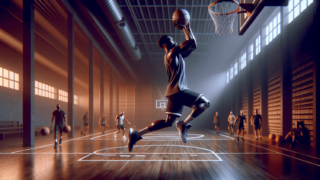
Welcome to the world of basketball intricacies, dear hoop enthusiasts! Today, we’ll delve into the art of the hesitation dribble, a move that can leave defenders reeling and pave your way to victory! Often overlooked, the hesitation dribble has become an essential ingredient in the skillset of top-tier players. Fasten your sneakers and keep your eyes on the ball as we break down this deceptive and highly effective move, equipping you with all the information to take your game to the next exhilarating level!
What’s a Hesitation Dribble in Basketball?
A hesitation dribble in basketball is a strategic move in which a player momentarily slows down or pauses their dribble to freeze or deceive their defender, before quickly accelerating past them. This dribbling technique creates an opportunity for the offensive player to catch the defender off-guard and drive toward the basket or create space for a shot.
Understanding the Hesitation Dribble Mechanics
The hesitation dribble consists of three critical components: the slow-down, the pause, and the acceleration. To master this move, it is essential to pay attention to each of these aspects, as well as how they seamlessly blend together. Let’s dive into the mechanics of this move, so you can leave your opponents in the dust on the basketball court.
The Slow-Down
The first step to executing a successful hesitation dribble is the slow-down. The offensive player lowers their dribbling speed while maintaining a low and wide stance. The goal is to make the defender believe that the attacker is either about to change direction or come to a complete stop.
The Pause
Next comes the pause – the pivotal moment in the hesitation dribble. During this brief moment, the ball handler appears to have stopped dribbling altogether, with one hand remaining on the ball. This is the deception aspect of the move, as the defender is likely to relax momentarily, thinking that they have successfully halted the offensive player’s advance.
The Acceleration
Lastly, and most crucially, is the acceleration. As soon as the defender’s guard is down, the offensive player springs into action, driving past their opponent using a quick first step and renewed burst of energy. With the defender caught off-guard, the ball handler has a clear path to the basket, making this a highly effective attacking maneuver.
How to Master the Hesitation Dribble
Understanding the mechanics of the hesitation dribble is one thing, but actually mastering it requires some practice. Here are some helpful tips and drills to help you elevate your game and add this powerful weapon to your basketball arsenal.
Developing a Quick First Step
Your first step after the acceleration phase is crucial, as it’s what will enable you to blow by your defender. Work on your footwork to increase your agility and quickness, and remember that your explosive first step should come directly after the pause, making it all the more effective.
Strengthen Your Ball Handling Skills
As with any dribbling move, the foundation of the hesitation dribble lies in strong ball handling skills. Practice dribbling with both hands, keeping your dribble low, and maintaining control over the ball, even at high speeds. The more comfortable you are with the ball, the more convincing your hesitations will be.
Observing the Defender’s Body Language
One of the critical elements of successfully executing a hesitation dribble is the ability to read your defender’s body language. As you slow down and pause, watch for signs of relaxation in their stance or any movement indicating that they’re preparing for you to change direction. These cues can help you time your acceleration perfectly, leaving your opponent scrambling in your wake.
Perfecting Your Timing and Rhythm
Timing and rhythm play a significant role in the hesitation dribble’s overall effectiveness. Practice varying your speeds and timing, finding the perfect rhythm that maximizes your chances of catching your defender off-guard. Experiment with different pause durations and acceleration styles to discover what works best for you and your unique playing style.
Drills for Hesitation Dribble Practice
By incorporating specific drills into your practice routine, you can fine-tune your hesitation dribble skills. Here are some popular drills to help you hone your craft:
- Two-Speed Dribbling: Practice dribbling in two speeds – fast and slow – while maintaining complete control over the ball. Start by switching speeds while stationary, then progress to doing so while moving up and down the court.
- Defensive Reaction Drill: Partner up with a teammate or friend who will play as the defender. As the offensive player, work on your hesitation dribble and watch their reactions. Focus on convincing them that you’ve stopped or are about to change direction, then practice accelerating past them.
- Chair Cone Drill: Set up chairs or cones to simulate defenders on the court. Run through the hesitation dribble, moving past the obstacles and working on your timing, acceleration, and deception techniques.
Utilizing the Hesitation Dribble During Gameplay
Now that you’ve familiarized yourself with the mechanics of the hesitation dribble and drilled it into your muscles, let’s explore how to effectively integrate this flashy move into your gameplay. Mastering the hesitation dribble and knowing when to deploy it on the court can significantly enhance your offensive capabilities.
Exploiting Defensive Missteps
Keep an eye on your defender and watch for moments when their attention or defensive stance falters. Any lapse in their concentration or a momentary shift in their stance can provide an excellent opportunity for you to use your newly developed hesitation dribble skills.
Switching up Your Offensive Approach
Variety is key when it comes to being an effective offensive player in basketball. If you’ve been using speed and aggression to drive past your defender, throwing in the occasional hesitation dribble can disrupt their expectations and create new openings on the court. Conversely, if you have been employing the hesitation dribble frequently, switching to a more aggressive approach can similarly catch your defender off-guard.
Adjusting to Your Opponent’s Tactics
As you become more proficient with the hesitation dribble, assess your opponents’ defensive tactics and adjust your approach accordingly. Some defenders may be more susceptible to hesitation dribbles due to their overly aggressive style, while others may play more conservatively, requiring different strategies. Use the hesitation dribble as a versatile tool in your basketball toolkit, modifying its application to match the unique challenges each game presents.
Penetrating Zones and Breaking Presses
When facing zone defenses or full-court presses, the hesitation dribble can create scoring opportunities and help your team break through tight defensive schemes. By utilizing the hesitation dribble, you can draw multiple defenders towards you, opening up passing lanes and creating space for your teammates to score.
Examples of NBA Stars Using the Hesitation Dribble
Many NBA stars have mastered the art of the hesitation dribble, utilizing it as an essential tool in their offensive repertoire. Let’s take a look at some of the greats who have effectively employed this move to devastating effect over the years:
- Stephen Curry: Known for his dizzying handles and uncanny ability to create his own shot, the Golden State Warriors’ point guard often uses the hesitation dribble to catch defenders off-guard before driving to the basket or creating space for his deadly jump shot.
- Kyrie Irving: The Brooklyn Nets’ star guard has an arsenal of offensive weapons at his disposal, with the hesitation dribble being one of his go-to moves. Irving uses his quick first step and impressive acceleration to leave defenders in the dust on his way to the hoop.
- James Harden: The crafty Houston Rockets shooting guard is known for his ability to draw fouls and create scoring opportunities from virtually anywhere on the court. By employing the hesitation dribble, Harden leaves defenders guessing, paving the way for him to unleash his array of offensive skills.
In conclusion, the hesitation dribble is a powerful basketball maneuver that can create scoring opportunities and leave defenders scrambling. By understanding the mechanics, practicing diligently, and learning when to deploy it during gameplay, you can vastly improve your offensive skills and become a more effective player on the court. So whether you’re just starting out or looking to add another weapon to your basketball toolkit, mastering the hesitation dribble can elevate your game and help you stay one step ahead of your competition.
Defensive Strategies to Counter the Hesitation Dribble
As a defender, it’s important to understand how to neutralize the hesitation dribble’s effectiveness. Whether you’re guarding an opponent who frequently employs this move or facing a player with a diverse skillset, implementing smart defensive strategies can help to minimize the impact of the hesitation dribble on the game. Here are some tips and techniques to enhance your defensive prowess.
Maintain a Balanced Stance
By keeping your defensive stance low and balanced, you’ll be better prepared to react to your opponent’s movements. Be sure to bend your knees, keep your feet shoulder-width apart, and stay on the balls of your feet to maintain quickness, stability, and agility. A solid stance will help you recover, even if momentarily deceived by a hesitation dribble.
Stay Patient and Focused
The hesitation dribble’s effectiveness lies in catching defenders off-guard. To counter this, maintain your focus and avoid overcommitting to your opponent’s movements. Staying patient and waiting for them to act can help you maintain a strong defensive position and reduce the chances of being fooled by the hesitation dribble.
Anticipate Acceleration
One of the most challenging aspects of defending against the hesitation dribble is reacting to the acceleration phase. To improve your odds of success, anticipate when your opponent may choose to explode into action. This keen awareness requires practice, but by developing this skill, you can better respond to sudden bursts of speed and maintain your defensive positioning.
Study Your Opponent
Get to know your opponent’s playing style, including their go-to moves and preferred techniques. By understanding their tendencies and habits, you can anticipate their actions more effectively and develop tailored defensive strategies to counter their offense. Additionally, studying their body language may reveal potential cues that can help you decipher a real move from a deceptive one, like the hesitation dribble.
Expanding on the Hesitation Dribble: Advanced Variations
Once you’ve mastered the basic hesitation dribble, you may wish to experiment with more advanced variations to keep defenders guessing and further cement your status as an offensive force on the basketball court. Here are some popular advanced variations to consider:
Change-of-Pace Hesitation
Similar to a traditional hesitation dribble, the change-of-pace hesitation involves the ball handler altering their speed, but instead of coming to a brief pause, they opt for a subtle but noticeable change in pace. This tactic can momentarily freeze the defender before the offensive player explodes off the dribble, creating an opportunity to get past their opponent.
Hesitation Crossover
The hesitation crossover is a combination of the hesitation dribble and a crossover dribble. As the offensive player pauses during the hesitation, they’ll perform a quick crossover, changing the ball’s direction and forcing the defender to quickly adjust. This move adds complexity to the hesitation dribble, making it even more challenging for the defender to predict and react to your next move.
Hesitation Step-Back
This variation of the hesitation dribble involves incorporating a step-back move right after the pause. As the defender’s focus shifts toward the potential drive or crossover, the offensive player quickly takes a step back, creating space for a jump shot or a pass. This move can be particularly effective for players with strong shooting skills, as it keeps defenders off-balance and guessing about their next move.
Implementing these advanced variations of the hesitation dribble can take your offensive game to new heights, adding more depth and complexity to your playing style. By always keeping your defender on their toes, you will become a more versatile and unpredictable offensive threat on the basketball court.
Frequently Asked Questions
In this FAQ section, we answer some of the most common questions related to the hesitation dribble, its execution, and its implications in basketball. Whether you’re an aspiring player or an intrigued fan, these answers will undoubtedly enrich your understanding of this fascinating move.
1. What is the primary purpose of the hesitation dribble in basketball?
The primary purpose of the hesitation dribble is to deceive and freeze the defender, enabling the ball handler to drive past them for an open scoring opportunity or create space for a cleaner shot.
2. Can I use the hesitation dribble legally, without getting called for a violation?
Yes, as long as you execute the hesitation dribble without palming or carrying the ball, it is a legal move and won’t result in any violations or penalties.
3. Is the hesitation dribble suitable for players of all ages and skill levels?
Absolutely! Players at any stage of their basketball journey can benefit from learning the hesitation dribble. However, it is essential to practice and hone this move to increase its effectiveness during gameplay.
4. Can the hesitation dribble be used effectively in both half-court and full-court situations?
Yes, the hesitation dribble can be utilized in various situations, including half-court offenses and full-court scenarios, such as breaking a press or penetrating a zone defense.
5. Do I need elite speed to execute a convincing hesitation dribble?
While having above-average speed can be beneficial, mastering the hesitation dribble primarily relies on timing, rhythm, and deception, which can be learned and developed through practice, regardless of natural athleticism.
6. How does perfecting the hesitation dribble benefit my overall offensive game?
By adding the hesitation dribble to your offensive toolkit, you become a more versatile and unpredictable player, forcing defenders to adapt and account for your wide range of moves, ultimately creating more scoring opportunities for yourself and your team.
7. Can I combine other dribbling moves with the hesitation dribble?
Yes, combining the hesitation dribble with other moves, such as crossovers and step-backs, creates a more dynamic and deceptive offensive approach, making it harder for defenders to predict and counter your actions.
8. Can the hesitation dribble be used against both man-to-man and zone defenses?
The hesitation dribble can be effective against both man-to-man and zone defenses, as it serves to create space and confusion, opening up opportunities for driving lanes or passing options.
9. Are there any particular drills that can help me improve my hesitation dribble?
Yes, there are several drills you can incorporate into your practice routine, such as two-speed dribbling, defensive reaction drills, and chair cone drills, to help you develop your speed, timing, deception, and ball handling skills related to the hesitation dribble.
10. How can I become better at defending against the hesitation dribble?
To defend against the hesitation dribble, focus on maintaining a balanced defensive stance, staying patient and focused, anticipating acceleration, and studying your opponent’s tendencies to adapt your defensive strategy effectively.
Featured Posts
- No pillar pages found.





